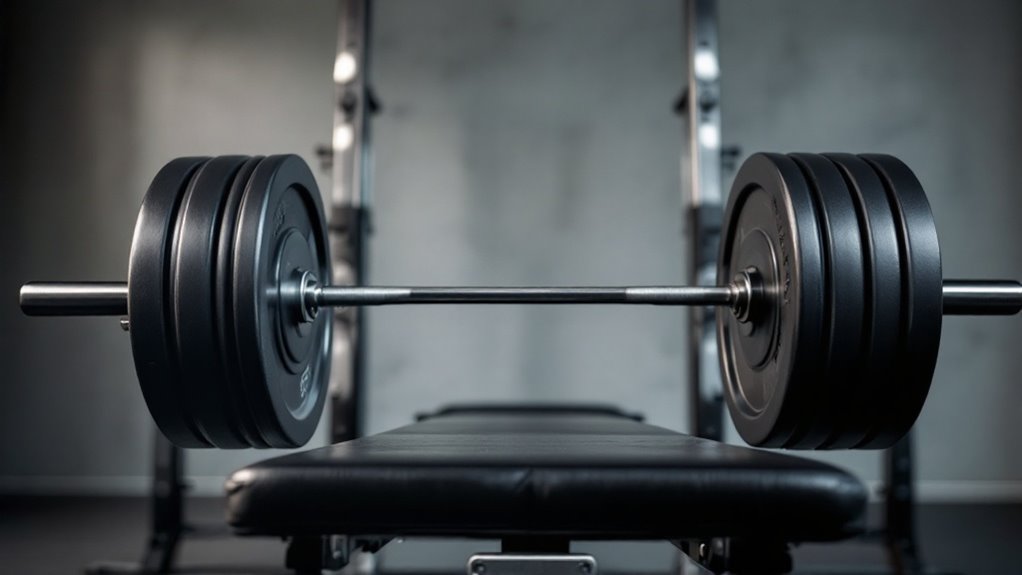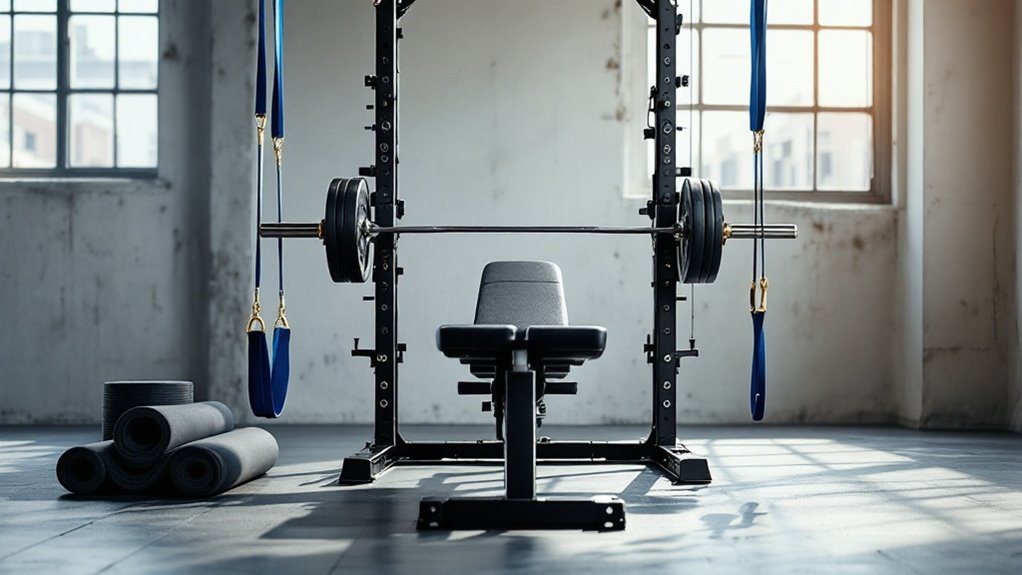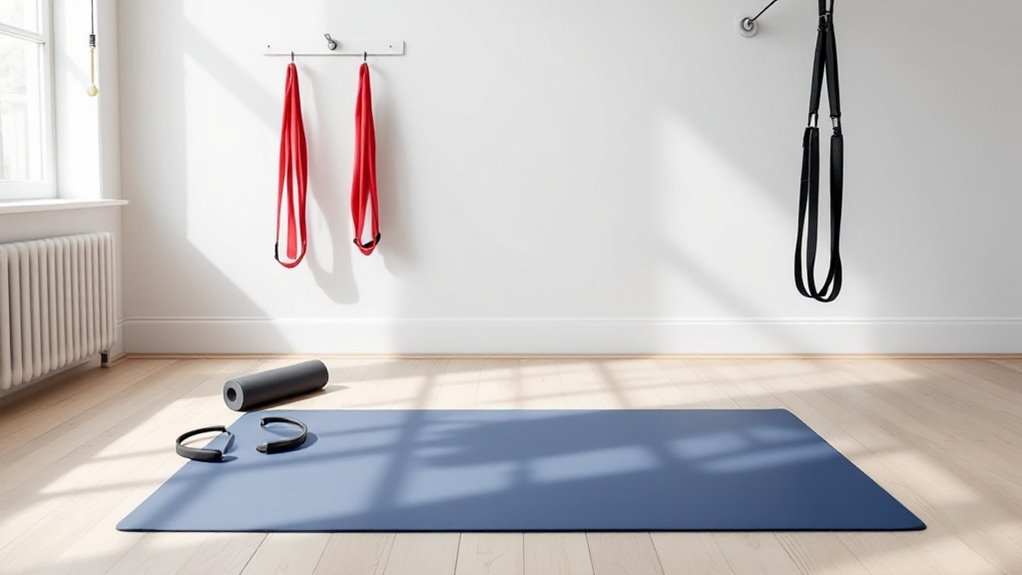Best Chest Exercises

The most effective chest exercises combine compound movements with targeted angle work. The barbell bench press at 70% of one-rep max optimizes muscle activation, while incline presses at 30-45 degrees isolate upper chest development. Bodyweight movements like push-ups and dips build foundational power, especially when improved with bands or plyometrics. Advanced techniques including drop sets and tempo manipulation break through plateaus. A strategic approach opens up maximum pectoral gains.
Key Takeaways
- Barbell bench press performed at 70% of your one-rep max provides optimal chest muscle activation and strength development.
- Incline dumbbell press at 30-45 degrees effectively targets upper chest muscles while reducing shoulder strain.
- Traditional push-ups and their variations offer effective chest development using only bodyweight and minimal equipment.
- Chest dips target the lower pectoral region while engaging stabilizer muscles throughout the upper body.
- High-to-low cable flyes on a 45-degree bench maximize chest fiber stretch and enhance overall pectoral development.
Compound Movements for Building Raw Chest Power

Crushing raw chest power starts with mastering fundamental compound movements that involve multiple muscle groups simultaneously. The barbell bench press serves as the cornerstone exercise, maximizing mid-chest activation while building overall upper body strength. Research shows that performing exercises at 70% of 1 rep max provides optimal muscle activation.
Chest dips and push-ups provide essential bodyweight resistance, targeting the lower chest and developing foundational power. Performing dips with parallel bar placement helps optimize engagement of the pectoralis major muscles. The incline dumbbell press at 30-45 degree angle effectively isolates and builds the upper chest region.
For advanced development, the dumbbell bench press challenges stability and unilateral strength, while the landmine chest press targets upper chest fibers with reduced shoulder strain.
These movements, when performed with proper form and progressive overload, create the foundation for impressive chest development and functional strength.
Angle-Specific Exercises for Complete Pectoral Development

While the traditional flat bench press remains a staple chest exercise, achieving complete pectoral development demands strategic angle manipulation to target all muscle fibers effectively.
Proper technique and execution using adjustable bench angles help maximize muscle activation and balanced development across the chest region.
The best approach includes incline bench pressing at 30 degrees, which optimizes upper chest activation while minimizing shoulder involvement. Understanding the pectoral fiber orientations ensures proper exercise selection for targeting specific chest regions.
A 30-degree incline angle creates the sweet spot for upper chest development, maximizing pectoral recruitment while keeping deltoid engagement minimal.
High-to-low cable flyes on a 45-degree bench create an ideal stretch across the clavicular head.
For extensive development, upper chest dips with a declined plant position target the often-neglected upper fibers through controlled torso positioning.
Controlled breathing patterns are essential for maintaining stability and power throughout chest pressing movements.
Incorporating sunrise/sunset band exercises provides continuous tension, ensuring thorough stimulation of all pectoral regions throughout the movement pattern.
Progressive Chest Training With Bodyweight and Minimal Equipment

Building an impressive chest doesn't require access to a fully-equipped gym or expensive machinery. Through strategic bodyweight training, remarkable results can be achieved using progressive resistance techniques and minimal equipment.
By incorporating band-loaded push-ups, TRX suspension systems, and resistance bands, trainees can continuously challenge their chest muscles. Core stability is essential for maintaining proper form and maximizing chest activation during these exercises. Focusing on proper breathing techniques during each repetition ensures optimal muscle engagement and performance. Similar to the shoulder press technique, maintaining strict form throughout each movement is crucial for optimal results.
Advanced methods like plyometric push-ups and eccentric-focused training add intensity without weights. Metabolic stress approaches, including high-rep protocols and supersets, stimulate muscle growth through increased blood flow and time under tension.
Varying angles and grips through incline, decline, and close-grip positions guarantees complete pectoral development while maintaining steady progression.
Advanced Techniques for Breaking Through Plateaus

Most fitness enthusiasts eventually encounter stubborn plateaus in chest development that require advanced training techniques to overcome. Breaking through these plateaus demands strategic implementation of methods like Post-Activation Potentiation (PAP), which uses heavy loads to improve subsequent performance. The 4-week program systematically progresses intensity to push past sticking points.
Drop sets and supersets create metabolic stress, while varied bench angles target specific chest regions. Proper execution of dumbbell chest flies with lighter weights emphasizes muscle tension and contraction quality over momentum. Following the principles of progressive overload ensures continuous adaptation and muscle growth. Unilateral training and isolation movements address muscle imbalances, particularly when combined with eccentric overload techniques.
Rest-pause sets and tempo manipulation extend time under tension, stimulating new growth. These advanced techniques should be cycled strategically to prevent overtraining while maximizing chest development.
Frequently Asked Questions
How Long Should I Rest Between Chest Exercises for Optimal Muscle Growth?
Rest periods between chest exercises should vary based on exercise type and intensity.
Compound movements like bench press require 3+ minutes for ideal recovery, while isolation exercises need 1.5-2 minutes.
For maximum hypertrophy, heavy loads (3-5 reps) demand 4-5 minutes rest, moderate loads (8-12 reps) need 2-3 minutes, and high-rep sets (15+ reps) require 60-90 seconds between sets.
Can I Train Chest Effectively if I Have Shoulder Impingement Issues?
Despite shoulder challenges, effective chest training remains possible through intelligent exercise selection and form modifications.
Athletes can focus on incline variations, floor presses, and controlled dumbbell work while avoiding aggravating movements like dips or wide-grip pressing.
Maintaining proper scapular positioning, utilizing narrower grips, and incorporating supplementary stability work allows for continued chest development without compromising shoulder health.
Should I Feel Chest Exercises More in My Shoulders or Chest?
Chest exercises should primarily be felt in the chest muscles, not the shoulders. While some shoulder involvement is normal due to their role as synergists, dominant shoulder activation indicates improper form or exercise selection.
When performing chest movements, focus on squeezing the pecs, maintaining proper form, and using appropriate angles. If shoulders consistently dominate, reduce weights and perfect technique before progressing.
What's the Ideal Chest Training Frequency for Natural Versus Enhanced Lifters?
Like ancient gladiators training for the arena, natural lifters thrive on 2-3 chest sessions weekly, allowing 48-72 hours between workouts for ideal recovery.
Improved lifters can push frequency to 4-6 weekly sessions, capitalizing on accelerated recovery capabilities.
Natural athletes should focus on quality over quantity, while improved lifters can handle higher volume and shorter rest periods between training days.
How Can I Fix Uneven Chest Development When One Side Is Larger?
Correcting uneven chest development requires a systematic approach focusing on the weaker side.
Implement dumbbell-based training to guarantee equal resistance, adding 12-15 extra weekly sets for the underdeveloped side.
Prioritize unilateral exercises like single-arm dumbbell presses and crossovers.
Reduce weights to emphasize proper form and mind-muscle connection.
Monitor progress through photos and measurements while maintaining consistent training frequency.
Final Thoughts
Like a master sculptor revealing beauty from raw marble, building an impressive chest requires both artistry and engineering. Through compound movements, targeted angles, progressive training, and advanced techniques, anyone can craft their ideal chest development. Studies show that chest muscles respond best to varied stimuli – just as Michelangelo used different tools to create David's perfect proportions, a well-rounded chest routine employs multiple approaches for peak results.


